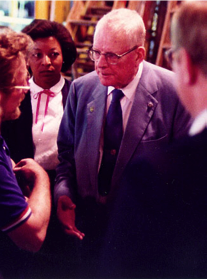There comes a time to leave every role behind—whether you are moving up, out, or on.  You don’t have to be at the end of your career and you certainly don’t want to be at the end of your rope and forced to leave before you consider: Is it time to move?
You don’t have to be at the end of your career and you certainly don’t want to be at the end of your rope and forced to leave before you consider: Is it time to move?
Just as you are never the last to leave a dinner or close down a bar—it just isn’t who you are—you are organizationally savvy enough to know when the party is in full swing and when it is winding down. You are alert and attentive, aligned with all your key stakeholders and your organizational goals. If you are self aware, mindful and intuitive, then you not only know how much time you have allotted to accomplish the task at hand, but you can also accurately calibrate how your organization values you and your accomplishments. You have staying power because you are able to assess when your stock is on the rise and when it is on the decline or about to tank. You have learned by now that everyone has a “shelf life” and an expiration date. Sharpen your observations. Pause, reflect and breathe.
Examine yourself through the eyes of your stakeholders and your managers or board. The questions are always the same: are you meeting or exceeding expectations? And, are you accomplishing your goals and, for some, securing your legacy? My friend Hensley often gauges progress by asking: Are you moving the needle?
Calibrate: How are you perceived regarding the expectations—yours and your stakeholders’—and what you have accomplished? How much time has elapsed? For example, if you’ve been in the role for less than six months and you are not meeting commitments and expectations, then you are in the wrong place. Exit before they ask you to empty your desk. On the other hand, if six months have passed and you are meeting  expectations and achieving your goals and commitments with passion, use your network, your charm and your organizational savvy to ensure that this role is either a springboard to your next opportunity or your crowning achievement.
expectations and achieving your goals and commitments with passion, use your network, your charm and your organizational savvy to ensure that this role is either a springboard to your next opportunity or your crowning achievement.
Remember: We almost always know when it is time to move on– the downside is that we
usually ignore our gut feelings. Why not get ahead of the game and trust your instinct. Remember, it is your choice.
From Chapter 17: Is it Time To Move?
 Have you considered the mindset that you will have on Wednesday, November 9, the day after the election? You have a choice—you can mindlessly repeat the pundits’ sound bytes and the unsavory words that characterize this election. You can disengage—walk away—with a wave of “whatever.” Or you can choose to wake up from the year-and-a-half-long election process and focus on creating a future that you want to live in.
Have you considered the mindset that you will have on Wednesday, November 9, the day after the election? You have a choice—you can mindlessly repeat the pundits’ sound bytes and the unsavory words that characterize this election. You can disengage—walk away—with a wave of “whatever.” Or you can choose to wake up from the year-and-a-half-long election process and focus on creating a future that you want to live in. –Mahatma Gandhi
–Mahatma Gandhi Q: I want to move from IT into biotechnology. I have a transferable skill set, but when I interview, they say I need biotech experience to be hired. Sounds like a Catch 22. What can I do?
Q: I want to move from IT into biotechnology. I have a transferable skill set, but when I interview, they say I need biotech experience to be hired. Sounds like a Catch 22. What can I do? from reading The Billion Dollar Molecule about the founding of Vertex Pharmaceuticals.
from reading The Billion Dollar Molecule about the founding of Vertex Pharmaceuticals. Being successful is one thing; being recognized for the value that you bring is another. The extent to which you are known determines your value. Value and visibility go together. Besides understanding what you bring to the party, you must know who in the organization values your contribution and why. Then you must communicate your “value-add” in order to get the outcome you desire.
Being successful is one thing; being recognized for the value that you bring is another. The extent to which you are known determines your value. Value and visibility go together. Besides understanding what you bring to the party, you must know who in the organization values your contribution and why. Then you must communicate your “value-add” in order to get the outcome you desire. Q: UGH! to the smutty campaign headlines. How do I handle conversations with my clients and friends?
Q: UGH! to the smutty campaign headlines. How do I handle conversations with my clients and friends? sure that many of you do, too, particularly the women. The shameful comments about our bodies. The disrespect of our ambitions and intellect. The belief that you can do anything you want to a woman. It is cruel. It’s frightening.
sure that many of you do, too, particularly the women. The shameful comments about our bodies. The disrespect of our ambitions and intellect. The belief that you can do anything you want to a woman. It is cruel. It’s frightening.  How do you respond to change? Do you avoid it, or do you say “Bring it on!” Do you see change as a continual flow or as episodic and event-driven? When you face change that originates outside your control, are you worried? afraid? excited?
How do you respond to change? Do you avoid it, or do you say “Bring it on!” Do you see change as a continual flow or as episodic and event-driven? When you face change that originates outside your control, are you worried? afraid? excited?

 Q: I came here to get away from a bad manager. Everything was great until– I can’t believe it– I got layered. Ugh! This guy doesn’t even know what I do.
Q: I came here to get away from a bad manager. Everything was great until– I can’t believe it– I got layered. Ugh! This guy doesn’t even know what I do.
 content of your role. But frankly, it is assumed that you have the content under control—that is why you received the promotion. The true key to appreciating and adjusting to your new reality is being aware of context. I often suggest that my clients draw a doughnut, put themselves in the center, on the next area write process and the outer circle “context.” The context is the environment you must navigate both in your organization and in your industry.
content of your role. But frankly, it is assumed that you have the content under control—that is why you received the promotion. The true key to appreciating and adjusting to your new reality is being aware of context. I often suggest that my clients draw a doughnut, put themselves in the center, on the next area write process and the outer circle “context.” The context is the environment you must navigate both in your organization and in your industry. improvements in both manufacturing and state government processes. Interestingly, psychologist Ellen Langer reached an appreciation for processes from a completely different starting point: not from a desire for statistical improvement but from her understanding of mindlessness and its corollary, mindfulness.
improvements in both manufacturing and state government processes. Interestingly, psychologist Ellen Langer reached an appreciation for processes from a completely different starting point: not from a desire for statistical improvement but from her understanding of mindlessness and its corollary, mindfulness. Q: My friends say that I avoid the big issues by kicking the can down the road. Frankly, I agree. I feel like my life is stuck.
Q: My friends say that I avoid the big issues by kicking the can down the road. Frankly, I agree. I feel like my life is stuck. before I dive into writing the next chapter of my new book.
before I dive into writing the next chapter of my new book. I often remind my clients that when they ask themselves “yes or no” questions about their abilities, the answer is almost always a resounding “no.” “Do I have the right stuff? Can I do this” are typical questions. It is much easier to see what’s wrong with ourselves than it is to recognize all the things that are not only “right” but also valued by others.
I often remind my clients that when they ask themselves “yes or no” questions about their abilities, the answer is almost always a resounding “no.” “Do I have the right stuff? Can I do this” are typical questions. It is much easier to see what’s wrong with ourselves than it is to recognize all the things that are not only “right” but also valued by others. view is not easy—it requires attention and practice. That’s why your personal marketing campaign will help keep you on course.
view is not easy—it requires attention and practice. That’s why your personal marketing campaign will help keep you on course.